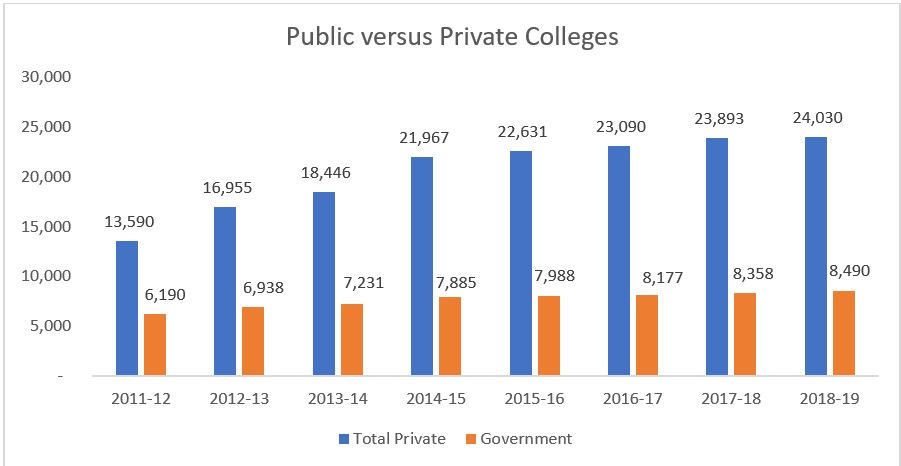Part I: Privatization
By Prof. (Dr.) Soumyadip Roy and Pavani Gupta

“Education is the most powerful weapon which you can use to change the world” -Nelson Mandela
India has the second largest population and the third largest higher education sector in the world. It is uniquely placed to change the world through education. India is also one of the youngest countries in the world. This phenomenon, which is also known as ‘demographic dividend’, leads to a large working-age population, which can boost economic growth. Such large cohorts of young adults entering the workforce is a blessing in terms of labor supply, but it also demands an ever-expanding higher education space.
The Indian higher education puzzle
A cursory glance at the state of higher education in India might be quite puzzling to someone unfamiliar with its intricacies. It is a system which produces CEOs of some of the largest and most prominent companies on the planet - Google, Microsoft, MasterCard to name a few; while at the same time it is not known for being home to world-class universities or as a centre of excellence in research. It lags dismally when it comes to several key indicators compared to advanced countries with more developed higher education systems, like Gross Enrollment Ratio[1] which is at 28.1% compared to 88.1% in USA and 50% in China – the two countries with bigger higher education sectors than India[2]. It ranks ninth in the world in terms of research output and is ranked 26th in terms of Higher Education System Strength[3].
We ask the question - Does the answer to this puzzle lie in how Indian higher education is divided between private and public institutions? The best institutes of higher education in India traditionally have been the public institutions across all disciplines, with few notable. This is primarily because of state-led growth since independence with a focus on social sector expenditure. The higher education sector is also undergoing rapid transformation since India’s economic reforms of 1991– there are more private players now than ever before.
Interestingly, the higher education space in India is more privatized than imagined. The latest report on the state of higher education in India brought out by the Ministry of Human Resource Development (MHRD)[4] reports that 77.8% of colleges in India are privately managed, which caters to 66.4% of total enrollment. These numbers are interesting – it suggests that although private colleges account for more than three-fourth of all colleges in India, they only enroll 66% of students overall. Therefore public institutions, who account for only 22.2% of colleges, enroll the remaining 33.6% of students and are under a lot of pressure to enroll more students than their capacity.
This raises several questions. Why is private education enrolling less students despite having a larger share of the higher education space? Is the higher cost of private education the reason? Also, is the growth of private colleges and universities coming at the cost of public institutions? Or are both growing by complementing each other? This leads us to the second question we address.
Are private and public institutes complements or substitutes?
Our research from the All India Survey of Higher Education suggests that the higher education space in India is getting more and more privatized in the last decade. At the beginning of the decade, in 2011, there were 13,590 private colleges and 6,190 private colleges (see figure 1). While both numbers grew substantially over the decade, private colleges almost doubled while government colleges only grew by 40%. These numbers show that the higher education space is getting more and more privatized. If we look at the total number of colleges as a pie, then private colleges used to occupy 69% of the pie in 2011 while it accounts for 74% of colleges in 2019. This comes at the cost of the public share of the pie which shrunk by 5% in this decade.

Figure 1: Number of higher education institutes, public vs private.
Source: All India Survey of Higher Education reports (2011-12 to 2018-19) .
Private education is more expensive than public education. The NSS 75th round report education in India reports private education to be twice as expensive in terms of cost per degree (Rs 19,972) as private education (Rs 10,501) at the undergraduate level for general subjects. The same is true for technical/professional degrees.[5] Therefore, greater privatization of higher education would imply that access to it will be limited to students coming from higher income backgrounds.
One might ask – what do these numbers mean for students entering the higher education domain after they complete their schooling? Simply put, more and more privatization has differential effects on the student population, depending on their socio-economic background. It is clear that the Indian higher education sector is growing at a phenomenal pace but the growth is not spread evenly between private and public institutions. The answer to this question will also have implications on the direction that Indian higher education takes in the long run. We might not see the benefits of our ‘demographic dividend’ if private education eats up the public share. Ideally, we would want a situation where the two complement each other with healthy synergies between them. Co-existence of the two might help improve India’s gross enrollment ratio, research output and university rankings. Sharing of knowledge, resources and personnel between them can bring about a revolution in the higher education. This is the model that most advanced countries with developed higher education systems have – a healthy mix of world-class private and public institutions. We hope that both public and private institutions grow, but not necessarily at the cost of each other. Only then Mandela’s dream of changing the world and making it a better place can be achieved through education.
This is part one of a two part series on Indian higher education. Please subscribe, to be notified when the second part gets published.
Prof. (Dr.) Soumyadip Roy is the assistant professor and assistant dean(international strategy) at JSBF. You can check his profile here.
Pavani Gupta is a 2nd year B.Com(Hons.) student at JSBF. You can follow her on instagram.
[1] India’s Gross Enrolment Ratio (GER) in higher education is 26.3% compared to 85.8% in USA and 48% in China, the only other countries with a bigger higher education sector than India.
[2] Source: Unesco: Gross enrolment by level of education, available at: http://data.uis.unesco.org/index.aspx?queryid=142
[3] Source: Scimago Journal and Country Rank: https://www.scimagojr.com/countryrank.php
[4] Please refer to the All India Survey of Higher Education (AISHE) report available at: http://aishe.nic.in/aishe/viewDocument.action?documentId=262
[5] Source: “Key Indicators of Household Social Consumption on Education in India”: NSS 75th Round available at http://www.mospi.gov.in/sites/default/files/publication_reports/KI_Education_75th_Final.pdf
Picture by The Financial Express.
Comments